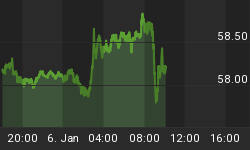The big question that has puzzled the investment community over the last few years has been "inflation, deflation, or both?" Those who make the case for inflation would point to the amount of fiat money printed over the last decade by central banks all across the world. They would also cite the ever-increasing appetite for "stuff" (i.e. commodities) among countries such as China & India. Deflationists would argue that the huge credit bubble that has been building must eventually end in some sort of deflationary bust. They would say that even in an easy-money environment, governments cannot push banks to lend forever and eventually a credit crunch would ensue. Finally, those who make the "both" argument would triangulate and say that the price of "stuff" would inflate while the prices of paper securities (stocks, bonds & perhaps mortgages) would deflate.
It certainly looks like the "inflation" and perhaps the "both" arguments have been the most accurate so far. But what about the predictions of the deflationists? We can remember people like Bob Prechter calling for a gold top around $300 or $400/oz a few years ago. We can also recall some DOW 3,000 forecasts from these deflationists during the last bear market. While it is easy to label these folks as gloom and doomers, their predictions of a debt-induced collapse in many global assets may not be so far fetched.
Over these last few years, the U.S. economy has experienced what we would call "controlled" inflation. We would say that inflation has ranged somewhere between 5% and 10% depending on one's consumption of fuel, medical care and collegiate education. Why this has not sparked outrage among the citizenry is twofold. First, bogus government CPI numbers as well as politicians & journalists blaming oil companies have helped distract the public. Second, some of this inflation has found its way (until recently) into stock & housing prices, which the American investor class seems to applaud. As long as your house and 401(k) go up in value, a little inflation here and there is acceptable.
Unfortunately, the fate of the American investor class will not be determined by American politicians or companies. Asia's insatiable appetite for natural resources has been a recurring theme in the financial media over the last few years. Since most commodities are traded in dollars, Asian consumers have had to deal with the same commodity price inflation that their American counterparts have. This will continue to be the case until Asian governments revalue their currencies versus the U.S. Dollar. Until now, this hasn't really happened because the Asian governments (especially China) know that if their currencies appreciate versus the U.S. Dollar, then demand for their exports will soften. Softer demand from the Wal-Marts of this world means that Chinese factories may not operate at full capacity which could trigger Chinese unemployment. This would be a major no-no because Chinese leaders understand that a little inflation (the current situation) is preferable to millions of unemployed young males. Governments tend to have trouble surviving in high unemployment environments.
So, if a little domestic inflation (and political pressure from G-7 treasury secretaries and finance ministers) won't push Asian central banks to revalue, what will? Our guess is that the answer lies in the food riots that are starting to spread across the globe. While a little commodity inflation is more politically tolerable than unemployment, food price protests & riots are another matter. After all, it was commodity hyperinflation (not deflationary stagnation) that served as the catalyst for the downfall of Weimar Germany and many Latin American governments last century.
If the riots continue to spread, especially into some of the more developed countries, then we think it is only a matter of time until the Chinese, Japanese, European, and even American central bankers climb aboard the inflation-fighting train. A hawkish Fed may be difficult to fathom, but if gas price increases start to bankrupt the entire transportation sector and we see truckers striking like they do in France, the political winds will shift. For a preview of what this political environment may look like, we suggest that readers dig up Jimmy Carter's speeches on YouTube or the Carter library web site.
Inflation is here and it is likely to continue for some time. But investors must watch for signs of the political winds shifting. The question to keep in mind over the coming months is whether it is more politically feasible to have severe inflation or severe deflation. We still believe rampant inflation and U.S. Dollar debasement is the most likely outcome in the short term. But, if riots and upheaval continue to spread, all out deflation may be the only antidote.
















